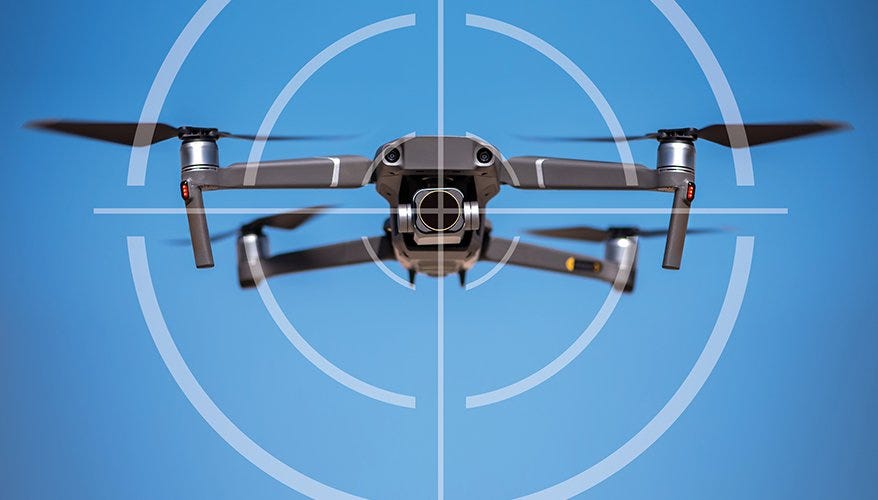The New Arsenal of War
Small teams + smart tech are outpacing industrial giants
Best wishes to all attending this week’s 12th annual Maritime & Arctic Security & Safety conference (MASS), which will dive into the topic of emerging threats and how Canadian companies are leading the way to provide a safe, secure, and successful future.
🎯 Three-Shot Burst
Industrial Might is Different in Modern War
The WW2-era model of big guns and bigger factories is out of date, argues The Economist. The prevailing belief is that wars are won by nations with the largest, most robust industrial bases - think Detroit carmakers churning out bombers during the Second World War.
Western governments fear they can’t keep up with adversaries like China or Russia without reviving vast manufacturing capacity.
Reality check: The war in Ukraine shows that nimble, dispersed production, like Ukraine’s fast-moving drone startups, can outpace legacy defence giants.
Furthermore, today’s factories are highly specialized and automated. Repurposing a car plant to build bombers is now impossible.
Small, adaptable firms can design and deliver new weapons in weeks, not years, and scale up production rapidly in response to battlefield needs.
Ukraine’s success with homegrown drones and improvised naval weapons has neutralized Russian advantages in ships and tanks, despite lacking traditional industrial muscle.
Bottom line: The most fungible asset is skilled labour. Engineers can be retrained faster than factories can be retooled. The private sector’s ability to innovate and adapt at speed is the real strategic advantage, not stockpiles of outdated hardware.
Related:
Canada’s high-tech defence imperative: When private actors develop technologies for commercial applications, defence budgets are relieved of the pressure to fund costly initial R&D phases
Canada looking at the possibility of complementing incoming F-35 fleet with fighter drones
Canada deploys explosive drone boat in first proof of ‘new operational concept’ for navy
NATO DIANA’s Robyn Warrier, based at the accelerator in Halifax, explores how Canadian dual-use innovation helps SMEs blend defence and commercial applications, offering new opportunities for growth and impact in the marine technology sector:
A new season of the GZERO/MDA podcast: The role of space in national security, the potential for space-based conflict, and the role of private space companies in this new era:
New US Navy memo maps tech priorities for the future fight. Quantum tops the list
Government of Canada promises to act swiftly to head off the threat of losing quantum computing companies to the U.S.
📋 Procurement Update
Mapping the Canadian dual-use technology ecosystem
[Editor’s note: Thanks to the 200+ companies that have already taken the survey!]
Canada is ramping up military spending to meet NATO targets. This is an enormous opportunity to propel the growth of our domestic tech sector through defence procurement.
Canada’s innovators are building world-class technologies. But too often, they fly under the government’s radar — we are often told that Canadian companies don’t have the necessary capacity to meet Canada’s defence needs, like $100M worth of the aforementioned binoculars.
The Department of National Defence (DND) and Canadian Armed Forces (CAF) want to change that, and it begins with mapping our private sector defence capacity.
Our first-of-its-kind industry survey, in partnership with the Council of Canadian Innovators (CCI), is your chance to put your company’s products and services on the government’s radar.
The federal government has asked CCI to build a market map of Canadian companies that can help serve Canada’s defence needs. The Icebreaker is pleased to formally partner with CCI to build this database of Canada’s strategic defence capabilities.
By sharing your insights, you’ll help us map the Canadian dual-use tech ecosystem and unlock new opportunities for collaboration, funding, and national impact.
If your company has technology that could be used in defence, please take 5 minutes to fill out the survey:
CCI and The Icebreaker will be sharing the information collected with the Government of Canada.
💾 Canada’s first Defence Tech Hackathon
September 20 in Toronto
The Icebreaker, in partnership with Build Canada and NordSpace, is excited to host Canada’s first defence tech hackathon.
The Defence Tech Hackathon is a catalyst to jumpstart a world-class ecosystem that builds sovereign capability in Canada. Our goal is to attract top talent, rapidly prototype real-world solutions, and bridge the gap between innovators and military end-users.
By forging new startups, building critical networks, and injecting a sense of urgency into defence innovation, this hackathon lays the foundation for Canada to compete and win on the global stage. We aim to advance the grassroots spirit of current and soon-to-be defence tech entrepreneurs.
We are still finalizing details, but here is what we know so far:
We will aim to rapidly prototype dual-use tech that solves real operational gaps for the Canadian Armed Forces
We are considering a challenge for a prototype platform that ingests multi-modal sensor feeds (satellite, UAV, radar, acoustic, etc.) and fuses them for real-time Arctic domain awareness
If you’re a software engineer who is defence-curious, this could be for you. We are looking for folks with domain expertise/experience in one or more of: defence, dual use tech (software and technology that can be used for both civilian and military applications), or Arctic operations; or who have any prior experience with multi-modal sensor fusion and real-time data platforms
🤝 Deal corner
Xubin Aerospace, Sentinel R&D building Canadian sovereign capacity
Oakville-based Xubin Aerospace is raising capital.
The counter unmanned aerial systems company has developed a proprietary ‘Eagle Vision’ technology that leverages AI to unmask incoming drone attacks at long-range.
The company is a recent winner of NATO DIANA’s 2025 global innovation hackathon, and is seeking pre-seed of $3.5M.
Reply to this email to be connected to founder Mostafa Najafiyazdi.
[Editor’s note: To have your raise featured in The Icebreaker, reply to us directly to let us know how you are building Canadian sovereign capability]
Related:
Catapult: Toronto-based Sentinel R&D, is seeking a modular launch solution tailored for medium-weight UAVs. Specifically looking for a catapult system with the following specifications:
Payload Compatibility: Capable of launching drones in the 10–50 kg range
Launch Velocity: Designed to achieve approximately 20 m/s initial velocity
Modular Launch Arms:
Interchangeable or adjustable arms to accommodate different UAV profiles
Designed to support future variants with minimal retooling
Preferred Launch Mechanism: Pneumatic system (other options can be considered if performance or logistics justify)
Reply to this email if you can help!
Valstad Raises $2.6M Pre-seed Round to Revive American Shipbuilding [N.B. Led by not one but TWO Canadian VCs]
⚔️ Combat Readiness
Drone Swarm
In a recent memo titled “Unleashing US Military Drone Dominance” that was directed towards the DoD and US Army, US Secretary of Defense, Pete Hegseth, cited his concern over the US military’s current arsenal of small drones, which have become a basic necessity in modern day warfare. In the memo, Hegseth declared the end of FY26 as the deadline to equip all active US Army squadrons with small, one-way attack drones.
The directive targeted small drone acquisition restrictions that were implemented by past administrations, specifically rescinding the 2022 “Exception to Policy Requirement for Blue Small Unmanned Aircraft Systems” memo as well as a 2021 memo that prohibited certain foreign entities from acquiring US-made drones. The aforementioned policies apparently made it more difficult for US military branches to procure sUAS for tactical applications.
Bottom line: Hegseth’s memo intends to equip every Army squad with an expendable first-person view (FPV) drone, the kind that were used in Ukraine’s Operation Spider’s Web attacking Russian airfields, within the next 15 months.
Related:
The WSJ and NYT with dueling longform pieces on why the Pentagon has made this announcement:
WSJ: A limitless supply of drones has frozen the front lines in Ukraine
NYT: Drones are key to winning wars now. The U.S. makes hardly any
Mission Driven: A conversation with Nini Hamrick and Brett Granberg, co-founders of Vannevar Labs. After working with intelligence agencies and meeting at Stanford’s GSB, Brett and Nini started Vannevar Labs to bring the best of Silicon Valley tech to the defence sector. Vannevar Labs is a defence technology company that builds software and hardware to support non-kinetic and intelligence missions worldwide to help the U.S. and its allies deter and de-escalate conflict:
To the moon: Pentagon orders the removal of any policies that slow down the development and deployment of drones, sending defence stocks higher
Equity Research: Areospace and Defence Technology note from Cannacord, dated July 14
🍁 Canada’s Inaugural Defence Power 50 List
The Icebreaker is excited to announce the opening of nominations for Canada’s inaugural Defence Power 50 List. The list will recognize the most influential leaders and up-and-comers in the defence community who are critical to making the changes Canada needs.
The selection of this inaugural 2025 list is co-chaired by Erin O'Toole, Glenn Cowan, Philippe Lagassé, Sheldon McCormick, and Eliot Pence.
Bottom Line: Nominate someone we should know about today!
🔫 Hot Shots
Agent Zero: US awards contracts of up to $200M each to Google, Anthropic, xAI, and OpenAI. The contracts will enable the DoD to develop agentic AI workflows and use them to address critical national security challenges, the DoD’s Chief Digital and Artificial Intelligence Office said
Bad actors: Terrorist organizations are trying to get their hands on Canada's tech to build weapons
Sneaky: Stealth UK startup building Iron Dome-like tech eyes $400 million valuation
Spider’s Web: Ukraine’s bold campaign of long-range drone strikes targeting Russian military and industrial infrastructure
Bend the curve: Germany’s Rheinmetall claims a €4,000 per engagement cost for its new drone-neutralization device, which if true dramatically brings down the intercept cost curve
Adaptability: Modern battlefield dominance is about learning faster than your adversary. It requires institutional adaptability, not hardware superiority
You’re doing it wrong: An example of the opposite of adaptability, from the US Navy
You’re doing it wrong, pt. 2: The Pentagon has taken a step back from supporting research and development of robotic land vehicles. The goal was to be able to move firepower on the front lines without risking the lives of tank operators:
Defence Hub: Invest Ottawa CEO Sonya Shorey, who runs Area X.O, makes the case for Ottawa as a national defence hub
Summer vacation: The French seaside factory trying to break China’s chokehold on rare earths
Demand side: EU defence demand for critical minerals could jump start Canada’s sluggish economy
Pilot project: What does it take to pass selection for one of Canada’s most elite aviation units?
Transparent: More money for Canada’s military should mean more transparency and accountability… Canada and its military spending quagmire
It’s a duel: In the Toronto Star, an op-ed warns that Canada must guard against China’s economic aggression; in the Globe & Mail, an op-ed argues that Canada must free ourselves of the U.S. and forge closer ties with China
🤝 Meet the Defence Tech Community
The Icebreaker is hosting another meetup, this time on the West Coast
Defence Tech Patio Drop In, August 14 in Victoria, B.C.: Sign up here to join VCs, founders, operators, defence primes, and the defence-curious, over a few cold beers on a sunny patio.
Too close for missiles, we’re switching to guns. Translation: the pace of news has slowed over the summer, so we’re switching to one newsletter per week for now. See you again Tuesday!
If you’ve got battlefield intel, classified tips, or just want to call in an airstrike on our typos, hit “reply” and sound off. Whether it’s a new tech sighting, a rumour from the mess hall, or feedback on our comms, we want your SITREP.








MASS was excellent and full of energy. Atlantic Canada is where a lot of the action will be from sensors to ships to submarines...